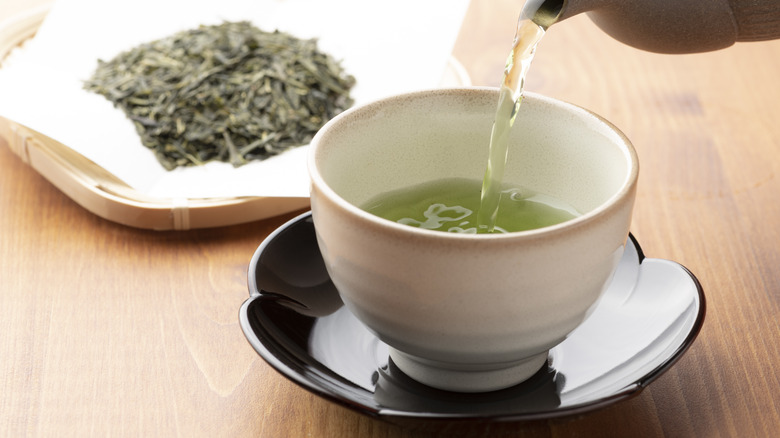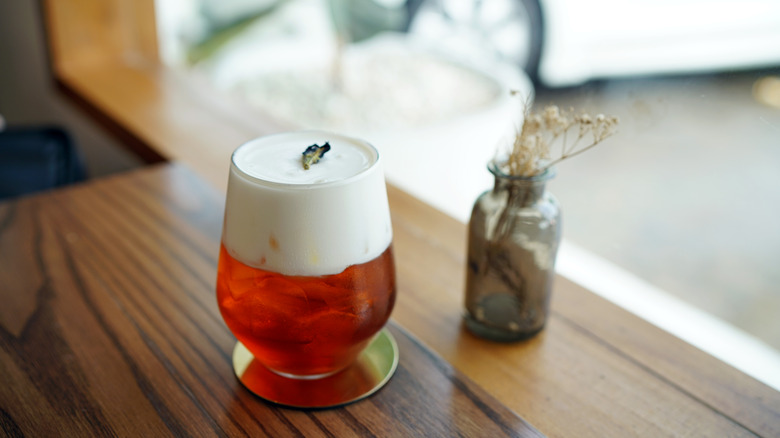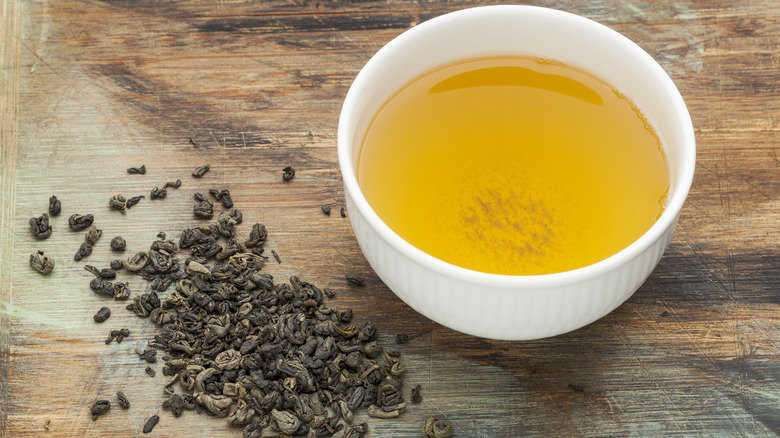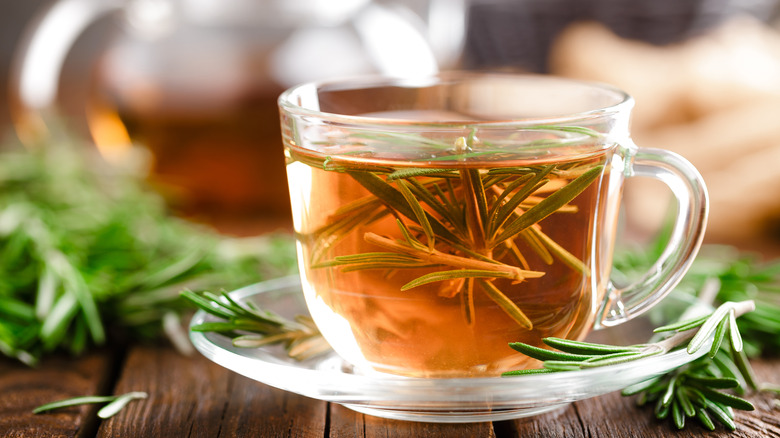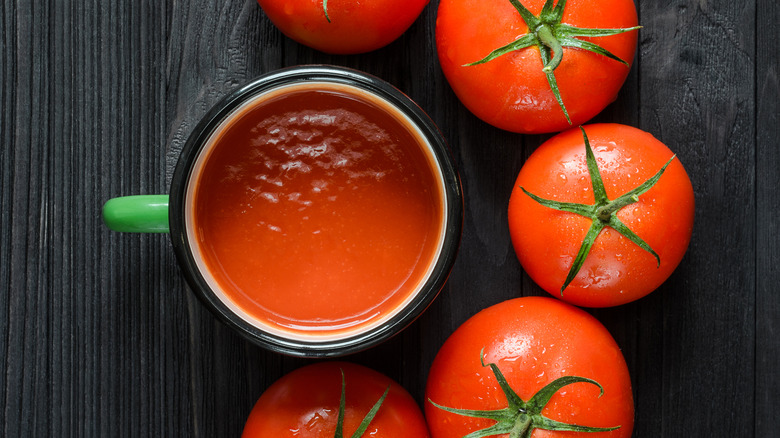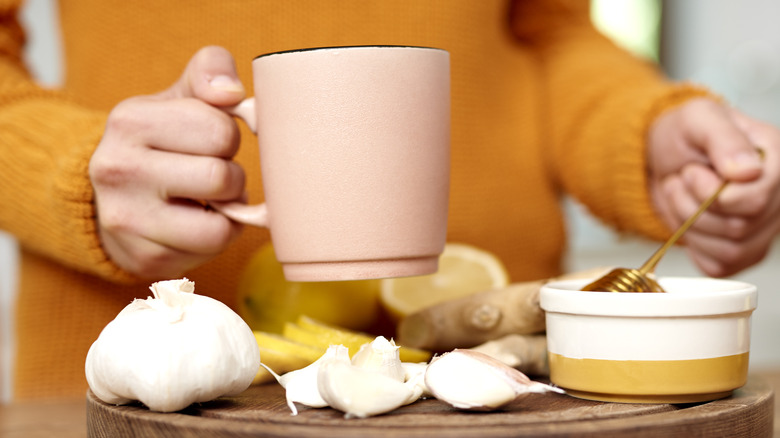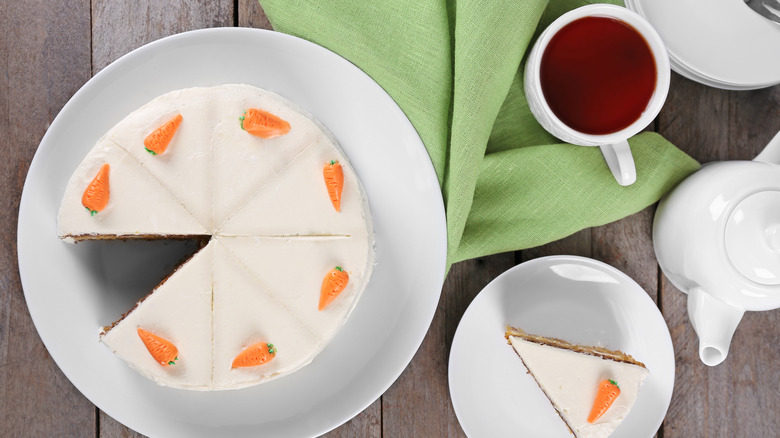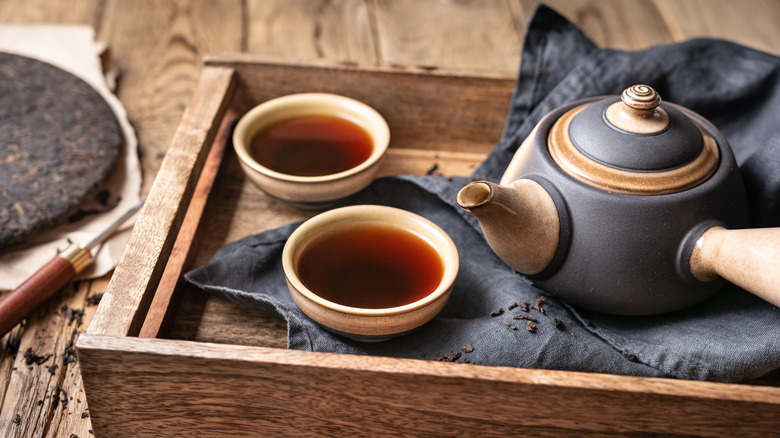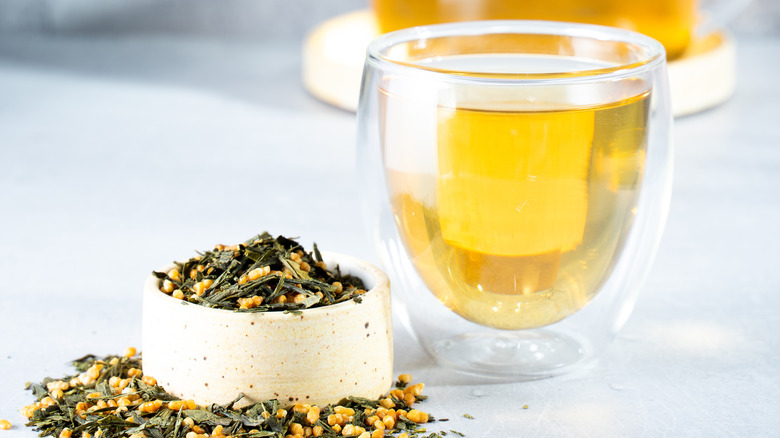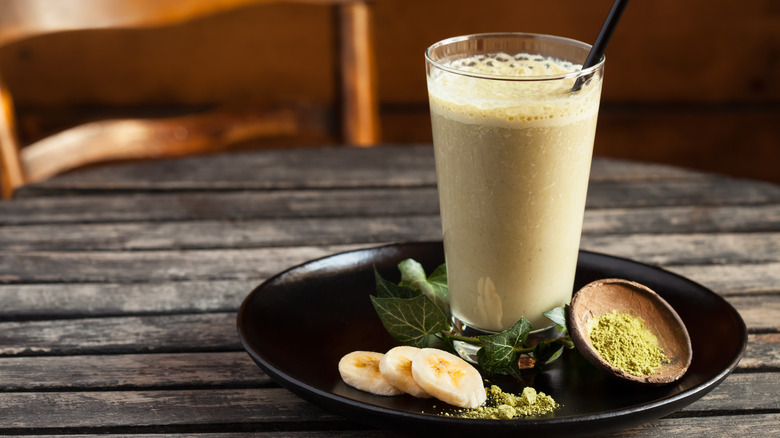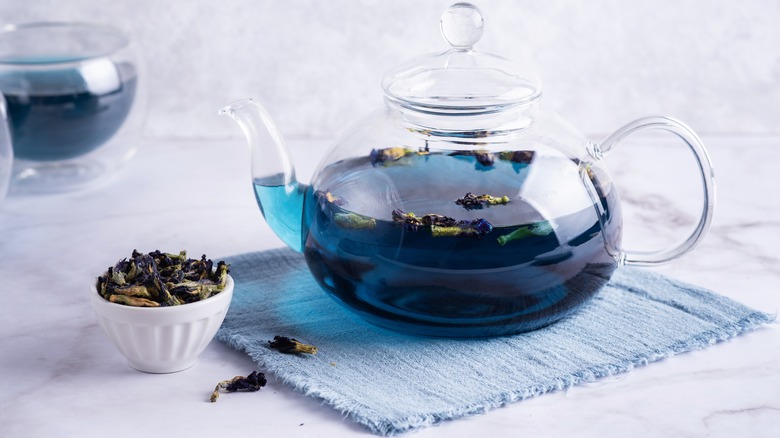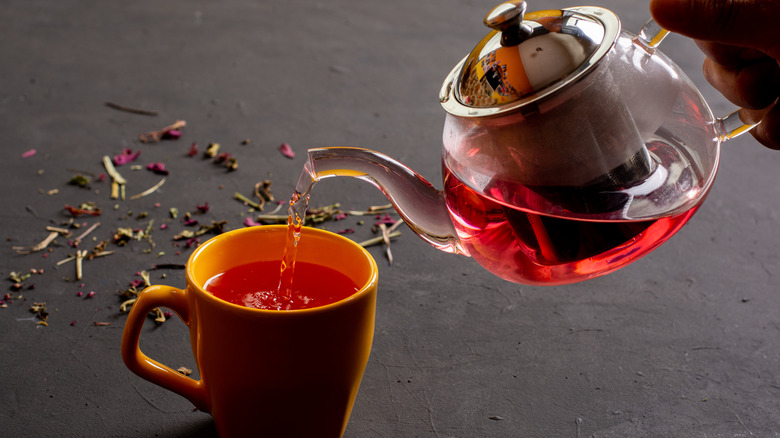Level Up Your Tea Game With 11 Unexpected Flavors
We may receive a commission on purchases made from links.
There is much to know about the world of tea, including the fact that it is the most consumed drink in the world after water, as well as the oldest, according to the Food & Agriculture Organization. Avid tea drinkers may also know that there are actually "true teas" and herbal teas. True teas, such as white, oolong, green, and black teas, derive from the Camellia sinensis tea plant, while herbal teas, like chamomile and rooibos, are combinations of plants, roots, and spices (via Sencha Tea Bar). All of these varieties of tea offer a wealth of different flavors, and potential flavor combinations that can feel personal to tea drinkers.
Anyone who drinks tea has a set of favorites — a favorite mug to use, a sweetening agent, and even a temperature preference. There's also undoubtedly a number of favorite flavors to choose from and a desired strength of tea. The strength of the flavor comes from the tea leaves, as how much the leaves oxidize when steeped will produce a subtle or strong flavor (via The Coffee Bean & Tea Leaf). For those looking to spice up their choices in tea flavors and strengths or just to try something new and fun, there's a world of tea flavors and styles that can only be described as unexpected.
1. Cheese tea satisfies the sweet tooth
Cheese tea — an odd thought but when inspected further, this combination is a decadent, fun treat. Typically served as an iced tea, the components of the drink include tea, most often black, matcha, or oolong, and a foamy cap layered on top. This cap consists of cream cheese, milk, whipping cream, and salt, according to Atlas Obscura. The mixture of salty, creamy, and sweet come together harmoniously in this beverage.
Several countries celebrate the mixture of salty and sweet in this way. Kaffeost, a cup of steaming coffee with a floating cheese cube, is popular in Finland and Sweden, while chocolate santafereño in Colombia is white cheese melted into a hot chocolate.
Cheese tea originated from the street markets of Taiwan in 2010 and eventually made headway around other Asian countries and, later, in certain areas in Europe and the United States. Cheese tea shop owners say the best way to enjoy this drink, is typically in a lidded cup tipped up at a 40-degree angle to get both tea and cheese mixture in one go (via Sencha Tea Bar). This way, the drink becomes one frothy beverage, which Little Fluffy Head Cafe owner Jenny Zheng says is necessary.
2. Try a smoky flavor with gunpowder tea
A bit of a misnomer, gunpowder tea does not get its name from the presence of gunpowder anywhere. In fact, in China, where the process of making this tea derives, this loose-leaf variety of green tea is called "pearl tea," according to Brewed Leaf Love.
Whichever identity you know it as, this type of tea is unmistakable by its appearance — the tea leaves are rolled up into little pellets, making them resemble gunpowder. The tea is known for having higher caffeine content than other green teas and has a bold, smoky flavor — even sought after by athletes for its reported effects on endurance (via The Tea Spot). Along with boosting your energy, gunpowder tea is anti-inflammatory, contains antioxidants, and may boost your metabolism.
To prepare gunpowder tea at home, steep tea for 1 minute. It tastes great iced and if green tea isn't your thing, it can be prepared using different tea varieties, including Assam, oolong, and black tea.
3. Rosemary is more than just an herb — it's tea
The humble rosemary plant is an herb that hails from the Mediterranean, typically used in cooking as a savory seasoning element that is bold in both flavor and scent. Its use is one of the most common in the world, according to TeaBackyard, as it can be used in nearly any type of dish — from perforating the crust of a rack of lamb or beef ribs to an infused simple syrup in a holiday cocktail. Its uses, of course, don't end there, as it can also be made into an herbal tea, or tisane.
Rosemary has been used for an array of ailments for centuries — even Queen Elizabeth of Hungary was suspected of using a rosemary tonic in her beauty and health regimens (via Buddha Teas). The family of plants that rosemary derives from is known to have active elements that are said to possess antibacterial, antiviral, antioxidant, and anti-inflammatory benefits. Rosemary has ben used for pain relief, healing minor wounds, and soothing coughs.
When preparing rosemary tea, opt for fresh rosemary and steep between 5 and 10 minutes. There is no limitation on steeping for flavor, as more time to infuse will not make the rosemary bitter. In the end, you'll have a balanced cup of tea that will linger on the tongue, similar to mint, and feel both soothing and savory on the taste buds.
4. Tomato tea
Savory teas may not necessarily be the norm, but some seek something different compared to the flavor profiles of the most popular teas. From vegetable scraps to wood chips, there are ways to pack flavor in some unorthodox ways — the same goes for creating a savory tea with tomatoes. Not only are tomatoes inherently healthy and worth adding to your culinary regimen, but they also work well when made into a tea.
Having a consistent intake of tomatoes can do a lot of good for the body in a variety of ways — from providing important nutrients during pregnancy to reducing cancer risks (via StyleCraze). As an ingredient, it plays a key role in dishes that exist throughout the world.
While tomato tea isn't necessarily popular, it's an interesting concoction that certainly leaves a distinct mark. While you can make your own tomato tea using tomato juice, you can also purchase dried tomato blends. Tomato tea pairs well with fresh flavors like mint, as Numi Organics has proven. It can also complement spices and deeper flavors, as evidenced by The Tea Club's Hangover Helper blend, which is both soothing and complex. Whatever your preference, the advantages of using tomato as a key ingredient will ensure a rich, earthy taste.
5. Garlic tea is great for your health
Garlic can be diced, crushed, and sliced and taste exemplary when roasted, sauteed, or even pickled. Many also know garlic as a heart-healthy ingredient. Studies conducted by the University of Oregon Linus Pauling Institute show that there are essential compounds in garlic that release when it is crushed, which can ultimately help protect the heart against cardiovascular diseases (via HealthShots). Overall, garlic has a lot of power — and this power can be put into a tea.
Garlic tea can be found both online and in stores, but the process of making it is easy enough that you may opt to do it at home. The basic recipe for garlic tea involves steeping lemon juice and honey with 3 to 4 cloves of garlic, though there are many variations of the recipe (via Verywell Fit). Ginger is a great addition to garlic tea, as it goes well with honey and lemon and boasts some health benefits of its own.
Garlic, in general, is full of vitamins, so starting the day with a mug of garlic tea is a great way to ensure you're getting plenty of nutrients. And while the tea is great for helping the heart, you should avoid drinking too many cups, as it can lead to an upset stomach or heartburn. Those susceptible to stomach issues may want to tread lightly.
6. Carrot cake tea brings dessert front and center
Carrots have been a popular ingredient in cakes for over 50 years, according to Fusion Teas. As a dessert, carrot cake is a unique creation, combining warm spices, shredded carrots, and nuts in a comforting sweet treat covered in a rich cream cheese frosting. Its flavors and composition mark it as a dish with distinct flavors that work well in a dessert, but potentially even better as a drink. Enjoying a mug of carrot cake tea will likely satisfy your sweet tooth.
Getting the flavor just right requires the use of simple ingredients, including carrots, walnuts, and ginger, as well as cinnamon, clove, vanilla, and maple to up the sweeter aspects of the dessert beverage. Generally, carrot cake tea can be found as an herbal tea and is typically caffeine-free (via Republic of Tea).
Some carrot cake teas are made with rooibos tea, which is a great choice for people with diabetes (via Healthline). Similar to black tea (sans the caffeine), rooibos tea is often paired with milk and sugar, turning a reddish brown color when steeped, which works perfectly for a carrot cake. The result is a soothing, satisfying blend of earthy spices and subtle sweetness that is exceptionally balanced.
7. Pu-erh tea showcases how fermentation affects flavor
Fermentation has seen a rise in popularity over the last few years, as has the exploration of the effects this process has on food and drink. Pu-erh tea derives its unique look and taste from this process, as the components are aged and partially fermented in several ways that can change the experience of the drinker, according to Artful Tea. Pu-erh tea usually comes in green and black varieties that fluctuate between mildly sweet, aromatic, and full-bodied (via Sencha Tea Bar).
The Sheng pu-erh variety is composed of leaves that are aged in a long, gradual process, while Shou pu-erh uses methods that are more modern and work at a faster pace. And just like anything else that ferments, the longer it takes to ferment the better, the richer the taste will become.
Depending on the type of pu-erh. there are a few different ways to brew. Some require steeping for 3 to 4 minutes or in increments of 10 seconds. Rinsing the leaves beforehand will also allow them to open and release gradually for a smoother flavor. The taste is a balance blend of fruity, earthy, musky, and peaty, resulting in a completely unique drink.
8. Genmaicha is more flavorful than you might expect
Genmaicha is a Japanese green tea made with brown rice kernels that, when enjoyed consistently, may reduce your risk for chronic diseases, according to Healthline. Because of its basic ingredients, it is a great tea to enjoy at breakfast. The mix of starch, sugar, and nutty flavors combined wonderfully in one mug.
Genmaicha originated in Japan, reportedly when Buddhist monks mixed green tea with the browned rice stuck to the bottom of their rice cauldrons (via Rishi Tea). Later it was cultivated by tea shop vendors who would mix green tea with roasted or sticky rice into one drink. These days, many commercial tea brands offer genmaicha.
"Genmaicha has the rare ability to pair equally well with both savoury and sweet options," tea sommelier Katie Cyr told tea brand VIVA. This even includes chocolate — salted caramel milk chocolate in particular. "I find the milk chocolate dissolves faster than the caramel and leaves a delicious taffy caramel that pairs beautifully with the oceanic and umami notes of the Genmaicha," Cyr explained.
It's recommended to steep this tea for 2 to 3 minutes to gain its full flavor, which ranges from grassy and wheaty to soft, mellow, and sweet. This tea is subtle yet well-balanced on the palate. The spent leaves can even be sprinkled on food or used to enhance soups or smoothies, so make sure not to throw them out right away (via Fusion Teas).
9. Banana matcha will curb your appetite for something creamy
Green tea can have a very natural, subtle taste on the palate that makes it seem fairly simple. However, matcha, a Japanese green tea, is known for its bold and earthy taste. Though matcha has a strong flavor, it is still fairly simple, which makes it a great base for other flavors. One combination that is certainly worth trying? Banana matcha.
The innate texture and taste of matcha is unique, as the tea leaves are grown under shade for weeks before being harvested and ground into a fine powder, according to Fraser Tea. The method you use to prepare matcha will adjust its texture — a smaller ratio of powder to water will give a thinner consistency, while equal parts will give a thicker, creamy mixture.
The banana and matcha combination works great over ice as well as hot, especially in a latte, as long as it's whisked until frothy (via David's Tea). For matcha novices, the recommended tools for creating a great cuppa include a scoop for precise measuring, a bowl to mix the powder into tea, and a tea whisk. A bamboo whisk is the most popular choice, which should be used in a zig-zag fashion to get the perfect consistency (via Three Leaf Tea).
10. Blue tea is more than just a pretty drink
Blue tea — who would have known that such a beautiful-looking beverage could also taste delicious and be good for you? This type of tea is also known as butterfly pea flower tea, according to NDTV Food, and is made from the leaves of the Clitoria ternatea plant that originally grows in South Asia. This tea is naturally free of caffeine and full of antioxidants that make it great for health-conscious folks.
"The blue flowers color and flavor the water, creating a 'blue tea,'" tea sommelier Jee Choe told Shape. The taste of the tea can fluctuate, much like its hue. Just a teaspoon steeped for about 3 minutes will create an intense, saturated sapphire color (via Teaswan). Sweetener is generally not needed, but honey or sugar can be added. Another great additive to this tea is lemon juice, which reacts with the tea's pH and changes color to a royal shade of violet (via NetMeds).
When finished, butterfly pea flower tea offers a complex taste profile, shifting from a woody, floral taste to a slightly tart flavor, similar to a hibiscus tea. The flavor is light, subtle, and flavorful on the palate without overpowering the senses (via America's Restaurant). It is sure to impress avid tea drinkers as well as cocktail lovers. In fact, the use of this tea in cocktails (as well as mocktails) can diversify your home bar recipes in a fun, unexpected way.
11. Horchata Lojana is a South American favorite
A niche flavor popular with South American residents and travelers, horchata lojana derives from the Loja region of Ecuador and has a herbaceous, floral flavor profile that makes it quite appealing as both a hot and cold beverage, according to World Food Guide. Temperature preference aside, when steeped, this drink benefits from sweetener and lemon juice, bringing out the natural flavor of the tea. This tea is a blend of many flowers and herbs. In fact, over 70 different types of medicinal herbs and plants can go into the mixture used to make horchata lojana tea — a majority of which can only be found in this region of the country (via EthnoBioMed). Lemon verbena, lemongrass, chamomile, bloodleaf, and lemon balm are commonly used. This unique composition is a staple within the southern region of Ecuador.
Every hand that tends to the creation of this tea is local, and every ingredient is sourced within, making it an incredibly special variety of tea. With the power of today's global markets, however, it's even easier to get your hands on locally developed products like this. Horchata lojana can be purchased online, giving you the ability to bring a flavor so important to the people of Ecuador into your own home.
